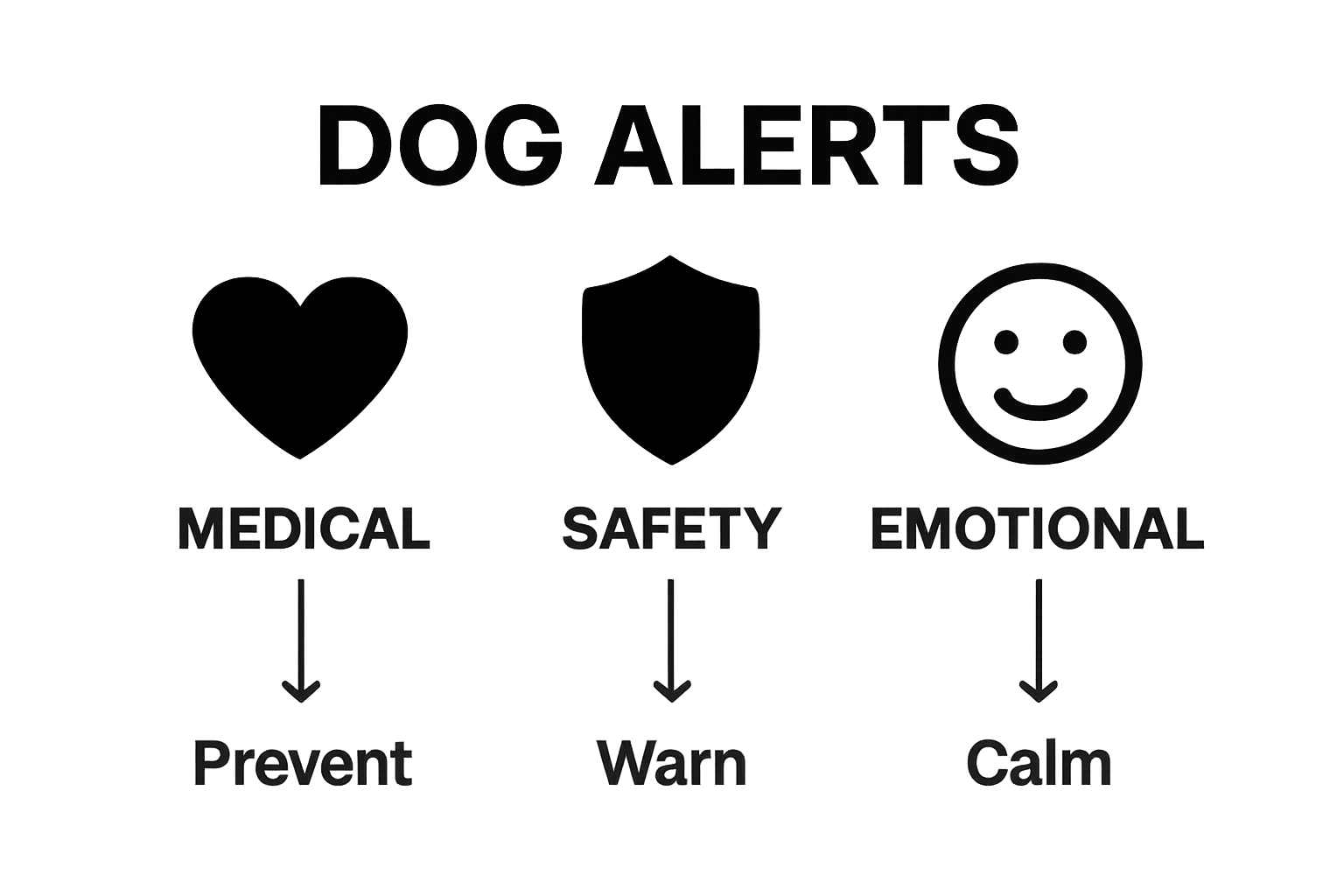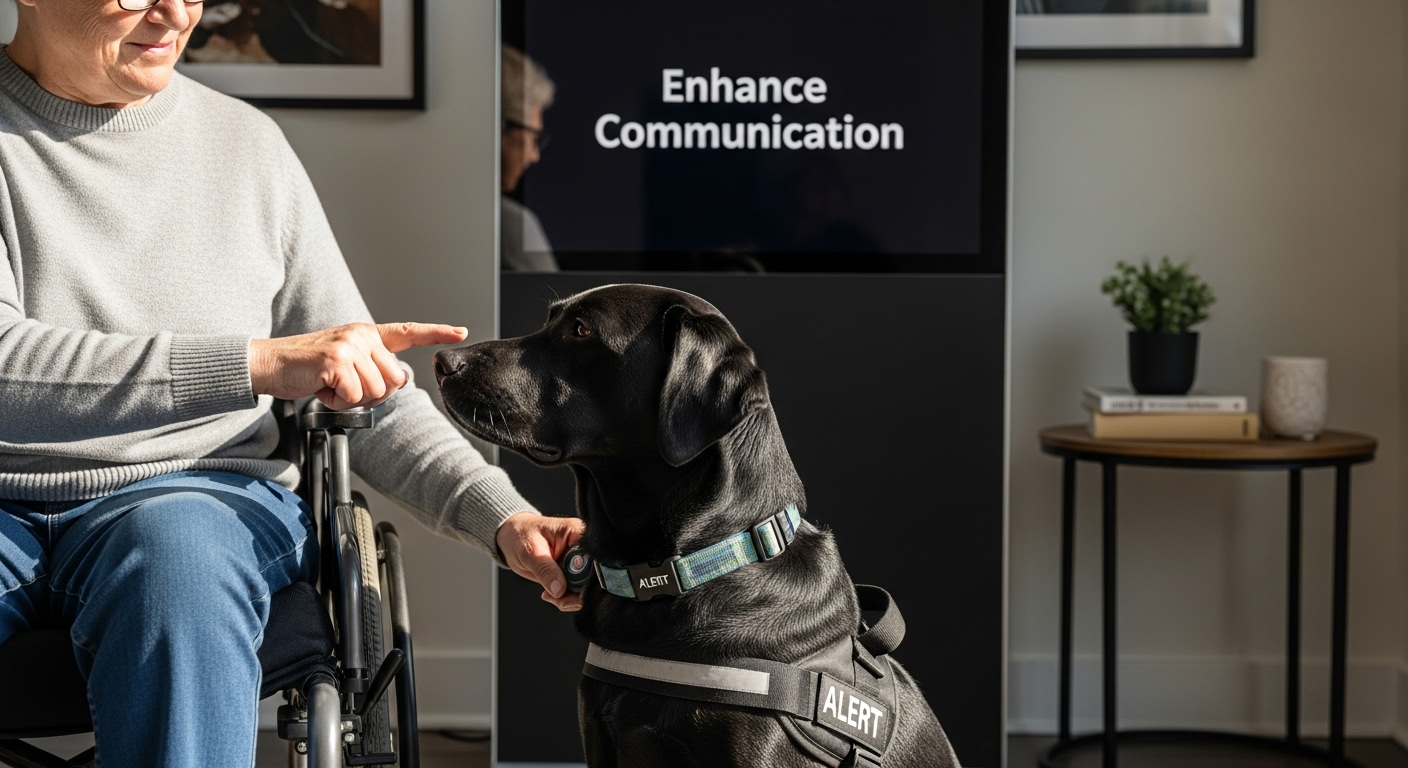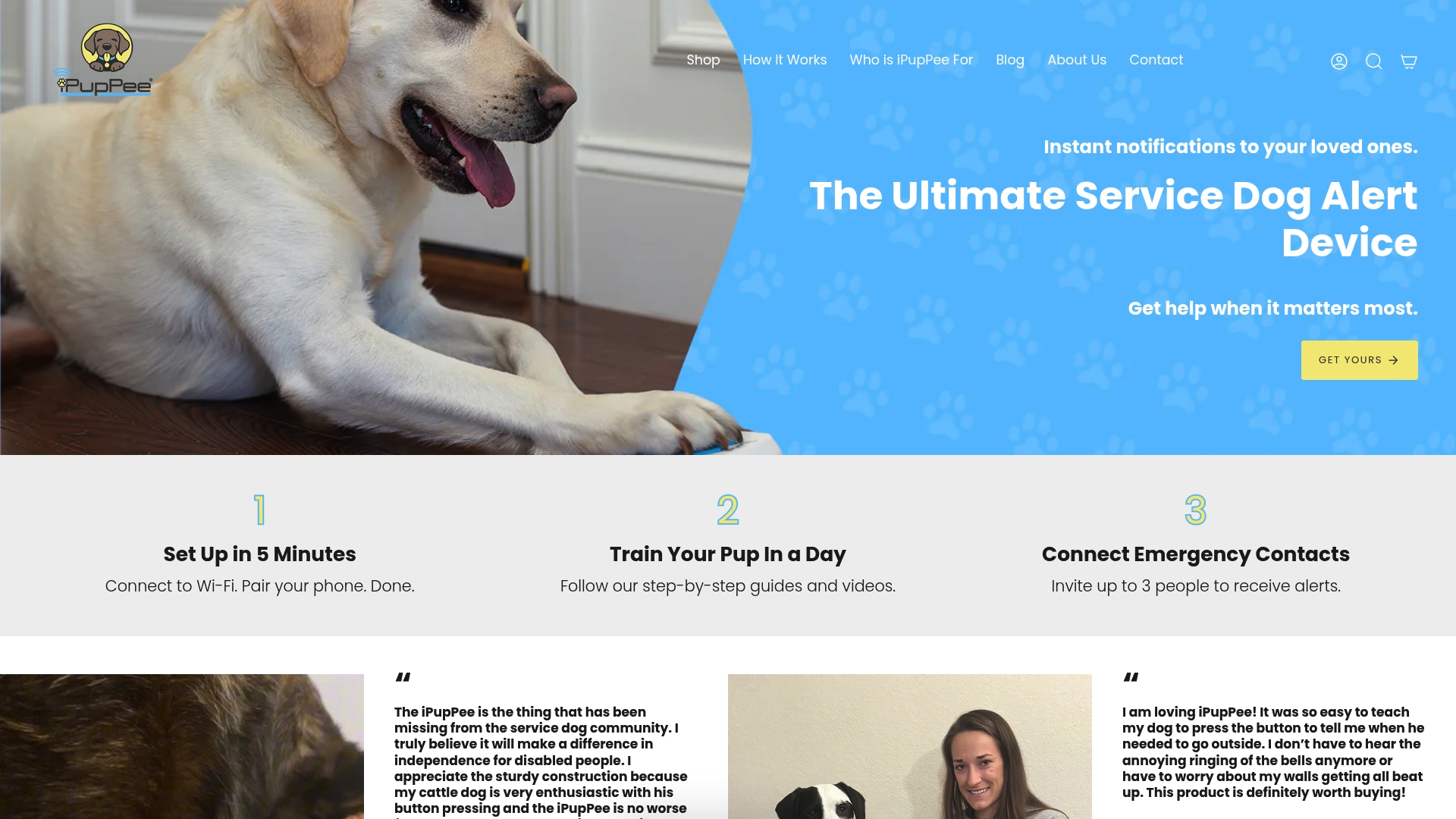Dog alerts have changed how people interact with their dogs. Some canines are trained to spot oncoming seizures or detect blood sugar changes with astonishing accuracy. In fact, studies show that trained dogs can recognize certain health events before any medical device does. Most expect barking or tail wagging to be the main signal, but these alert systems rely on subtle, learned behaviors that go far beyond basic commands. The real surprise is how these signals allow for a whole new level of communication between humans and dogs.
Table of Contents
- What Are Dog Alerts And Their Purpose?
- The Importance Of Dog Alerts In Different Situations
- How Dog Alerts Enhance Communication And Safety
- Real-World Applications Of Dog Alerts For Various Users
- Key Factors To Consider When Using Dog Alerts
Quick Summary
| Takeaway | Explanation |
|---|---|
| Dog alerts facilitate crucial communication. | These systems allow dogs to signal important information about health and safety to their handlers. |
| Trained dogs can detect health crises. | Medical alert dogs can warn handlers about conditions like seizures or changes in blood sugar levels. |
| Consider user-specific needs for training. | Successful implementation relies on understanding individual requirements for effective communication and safety. |
| Maintain and evaluate alert systems regularly. | Continuous monitoring ensures that dog alerts remain accurate and adapted to the changing needs of users. |
| Enhance emotional support through alerts. | Dog alerts also help manage mental health issues by providing immediate notifications of emotional or stress-related triggers. |
What Are Dog Alerts and Their Purpose?
Dog alerts represent an innovative communication method that enables dogs to communicate critical information to their human companions through specialized signaling techniques. These alert systems transform how humans and dogs interact, particularly in scenarios involving medical conditions, safety concerns, or specific service needs.
Understanding the Core Concept of Dog Alerts
At its fundamental level, a dog alert is a trained behavioral response where a dog communicates a specific message or signals a particular condition. These alerts can range from medical warning signals to safety notifications. According to research from the National Service Animal Registry, dogs can be professionally trained to recognize and communicate various critical situations.
Key characteristics of dog alerts include:
- Purposeful communication method
- Specific, learned behavioral signals
- Tailored to individual human needs
- Can address medical, emotional, and safety requirements
Types of Dog Alert Communication
Dog alerts manifest in multiple forms, each serving distinct purposes. Medical alert dogs, for instance, can signal impending health events like seizures, blood sugar changes, or anxiety attacks. Some dogs are trained to press specialized communication buttons or use physical gestures to convey messages.
Interested readers can learn more about advanced dog alert options to understand the full range of communication possibilities. These systems demonstrate how canine intelligence and human training can create powerful, life-enhancing communication strategies.

Whether supporting individuals with disabilities, providing safety monitoring, or offering emotional support, dog alerts represent a sophisticated intersection of animal behavior and human needs. By understanding and implementing these communication techniques, dog owners can unlock unprecedented levels of interaction and support from their canine companions.
The Importance of Dog Alerts in Different Situations
Dog alerts serve critical functions across multiple life scenarios, transforming how individuals manage health, safety, and communication challenges. These sophisticated communication systems demonstrate the remarkable capacity of trained dogs to provide targeted support in diverse environments.
Medical and Health Support Scenarios
According to medical research from the National Institutes of Health, dogs possess an extraordinary ability to detect physiological changes before human perception. Medical alert dogs can recognize and signal critical health events such as:
- Impending seizures
- Blood sugar level fluctuations
- Potential heart rate irregularities
- Onset of panic or anxiety attacks
These alerts provide individuals with chronic conditions or disabilities an additional layer of protection and early intervention, potentially preventing serious medical complications.
Safety and Emergency Communication
Beyond medical support, dog alerts play a pivotal role in safety and emergency communication. Service dogs can alert individuals to environmental dangers, potential threats, or immediate assistance requirements. For those interested in exploring advanced alert mechanisms, our guide on dog alert systems offers comprehensive insights into these sophisticated communication strategies.
For individuals with hearing impairments, specially trained dogs can signal doorbell rings, alarm sounds, or approaching vehicles. Similarly, mobility assistance dogs can alert handlers to potential physical obstacles or imminent balance challenges, providing an additional safety mechanism.
Emotional Support and Mental Health
Dog alerts extend beyond physical health, offering crucial emotional and psychological support. Trained dogs can recognize and signal escalating stress levels, anxiety symptoms, or potential emotional triggers. By providing immediate, non-verbal communication, these alert systems help individuals manage mental health challenges more effectively, creating a supportive and responsive environment that promotes emotional well-being and independence.
How Dog Alerts Enhance Communication and Safety
Dog alerts represent a revolutionary approach to interpersonal communication and safety, leveraging the extraordinary sensory capabilities of canines to bridge critical information gaps. These sophisticated communication systems transform how individuals with diverse needs interact with their environment and receive vital information.
Advanced Sensory Communication Mechanisms
According to research from animal behavioral experts, dogs possess remarkable sensory perception that enables them to detect subtle environmental and physiological changes humans cannot perceive. Their communication methods go beyond traditional verbal or visual signals, creating a nuanced and highly responsive alert system.
Key sensory communication capabilities include:
- Detecting minute changes in human body chemistry
- Recognizing subtle environmental shifts
- Interpreting complex emotional and physical signals
- Translating sensory information into actionable alerts
Safety Enhancement through Proactive Alerts
Dog alerts provide proactive safety mechanisms that anticipate and prevent potential risks. For more comprehensive insights into emergency alert strategies, explore our detailed guide on advanced communication techniques. These alerts can help individuals with disabilities, seniors, and those with specific medical conditions navigate daily challenges more confidently.
In emergency scenarios, trained dogs can signal potential dangers such as approaching strangers, fire, gas leaks, or medical emergencies. Their ability to provide immediate, non-verbal communication creates an additional layer of protection that traditional safety systems cannot match.

Psychological and Emotional Support Communication
Beyond physical safety, dog alerts offer profound psychological benefits. By providing consistent, reliable communication, these alert systems help reduce anxiety, increase independence, and create a sense of security for individuals who might otherwise feel vulnerable. The non-judgmental and immediate nature of canine communication provides a unique form of emotional support that transcends traditional human interactions.
Real-World Applications of Dog Alerts for Various Users
Dog alerts have revolutionized support mechanisms across diverse user groups, demonstrating remarkable versatility in addressing complex communication and safety challenges.
The following table summarizes the main types of dog alert applications discussed in the article, highlighting their purpose and typical user groups.
| Dog Alert Application Type | Main Purpose | Typical User Groups |
|---|---|---|
| Medical and Health Management | Detect physiological changes and warn of medical events | Individuals with chronic conditions |
| Accessibility and Independence | Enhance daily safety, navigation, and independence | People with disabilities, seniors |
| Emotional and Psychological Support | Provide immediate response to stress or emotional triggers | Individuals with anxiety or PTSD |
Medical and Health Management Applications
According to medical research published in the Journal of Medical Detection, dogs can detect multiple health conditions with extraordinary precision. These alert systems offer critical support for individuals managing complex medical situations, providing real-time monitoring and immediate intervention capabilities.
Specific medical alert applications include:
- Diabetes management through blood sugar level detection
- Epilepsy seizure prediction and warning
- Cardiovascular event anticipation
- Neurological condition monitoring
Accessibility and Independence Support
For individuals with disabilities, dog alerts create unprecedented opportunities for enhanced independence and safety. For practical insights into device usage, explore our comprehensive guide on integrating alert systems into daily routines. These communication mechanisms enable users to navigate environmental challenges more confidently, reducing dependence on human assistance.
Special needs populations benefiting from dog alerts include:
- Hearing-impaired individuals
- Mobility-challenged users
- Individuals with neurological conditions
- Seniors requiring additional safety monitoring
Emotional and Psychological Support Applications
Beyond physical health management, dog alerts provide profound emotional support. These systems help individuals manage anxiety, stress, and psychological challenges by offering immediate, non-verbal communication. Trained dogs can recognize emotional triggers, providing a unique form of psychological intervention that traditional support mechanisms cannot replicate.
Key Factors to Consider When Using Dog Alerts
Successful implementation of dog alerts requires careful consideration of multiple complex factors.
This table outlines key factors to consider when implementing dog alert systems, summarizing each factor and its specific considerations as discussed in the article.
| Factor | Description | Specific Considerations |
|---|---|---|
| Training and Skill Development | Ensures dogs are prepared to perform required alert tasks | Signal recognition, environmental adaptation, performance consistency |
| Individual User Assessment | Aligns alert systems with user needs and capabilities | Mobility, cognitive, and emotional compatibility, daily routines |
| Maintenance and Performance Eval. | Keeps alert systems accurate and responsive over time | Regular monitoring, retraining, updating alert protocols |
Training and Skill Development
According to veterinary behavioral research, comprehensive training represents the foundational element of effective dog alert systems. Professional training must address not just the technical alert mechanisms but also the broader context of human-canine communication and specific user requirements.
Critical training considerations include:
- Precise signal recognition and communication protocols
- Consistent performance under varying environmental conditions
- Adaptation to individual user’s specific medical or safety needs
- Maintenance of alert responsiveness over time
Individual User Assessment and Compatibility
Successful dog alert implementation demands thorough evaluation of the user’s unique circumstances. For detailed insights into advanced training techniques, explore our comprehensive guide on preparing dogs for specialized alert roles. This assessment involves understanding the user’s physical capabilities, lifestyle constraints, and specific communication requirements.
Key compatibility factors include:
- Physical mobility and interaction capabilities
- Cognitive processing and communication preferences
- Living environment and daily routine complexity
- Emotional and psychological support needs
Ongoing Maintenance and Performance Evaluation
Dog alerts are dynamic systems requiring continuous monitoring and periodic reassessment. Regular performance evaluations help ensure the alert mechanism remains accurate, reliable, and responsive to evolving user needs. This process involves professional assessment, periodic retraining, and adapting alert protocols as the user’s circumstances change.
Experience the Power of Real-Time Dog Alerts With iPupPee
Are you struggling to bridge the communication gap between you and your dog or searching for ways to feel safer and more confident in everyday life? The article highlights how essential dog alerts are for health, safety, and independence. If you want instant notifications from your dog about pressing needs or emergencies, it is time to explore a truly innovative solution.

Discover how the iPupPee alert device transforms canine communication for people with chronic conditions, seniors, and families living with service or support dogs. This simple, button-activated system empowers your dog to send clear signals for help or attention with just one press. See how real users are boosting confidence and freedom in their homes by visiting our customer testimonial section and get practical training tips from our featured blog. Do not wait until an urgent situation goes unspoken. Take charge of your safety and peace of mind by exploring ipuppee.com and see how easy it can be to unlock better communication with your canine companion today.
Frequently Asked Questions
What are dog alerts and how do they work?
Dog alerts are trained behavioral responses where dogs communicate critical information to their human companions using specific signals. These alerts can inform about medical conditions, safety notifications, or emotional support needs.
What types of medical conditions can dog alerts assist with?
Dog alerts can assist with various medical conditions, including impending seizures, blood sugar fluctuations, anxiety attacks, and other health-related emergencies. They provide early warnings and help with management of chronic conditions.
How do dog alerts enhance safety for individuals with disabilities?
Dog alerts enhance safety by providing proactive notifications about environmental dangers, potential threats, or immediate assistance needs. They support users with hearing impairments or mobility challenges by alerting them to important sounds or physical obstacles.
What factors should be considered when implementing dog alerts?
When implementing dog alerts, it’s important to consider the dog’s training and skill development, the individual’s specific needs, and ongoing maintenance to ensure the alert system remains effective and reliable.

